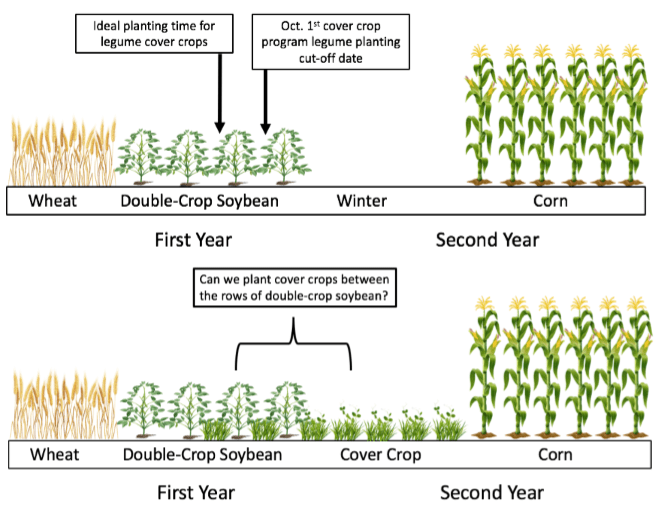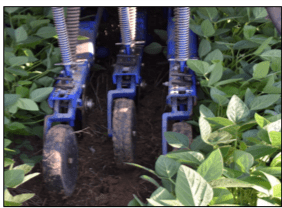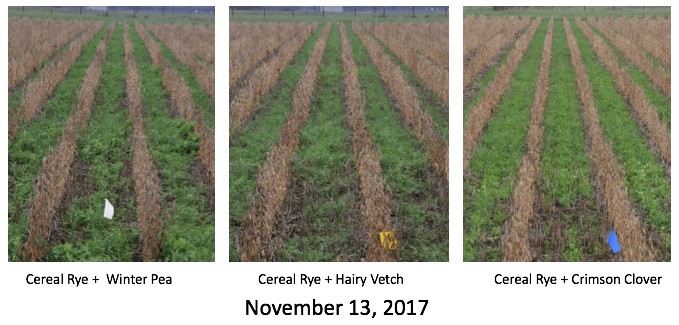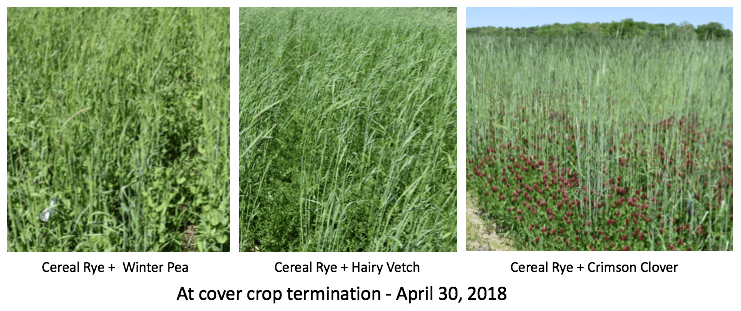1,2Cara Peterson, 2Steven Mirsky, 1Kate Tully, 1,2Victoria Ackroyd
1Department of Plant Science and Landscape Architecture, University of Maryland
2United States Department of Agriculture, Agricultural Research Service, Beltsville
The mid-Atlantic region has the highest percentage of arable acreage in cover crops in the United States, with some reports placing Maryland and Delaware as the two states with the highest percentage of total cropland planted with cover crops (Wade et al., 2015; Hamilton et al., 2017). However, the majority of producers in the region are only using grass cover crops, since legumes require earlier planting dates in order to over-winter (Mirsky et al., 2011; Clark, 2012). Farmers in this region have success with legume cover crops when planting them after wheat harvest or frost-seeding in the spring. However, most mid-Atlantic crop rotations include double-crop soybeans planted after wheat, which limits opportunities for establishing a legume cover crop. Low legume adoption is particularly problematic as farmers could use this cover crop before corn to maximize the opportunity for nitrogen fixation benefits.

Some farmers interseed cover crops into growing cash crops to overcome this timing challenge. Current options for planting cover crops into standing corn and soybean include both aerial broadcasting via airplane and adapted high-boy sprayers. However, these two techniques often result in poor establishment due to low seed-to-soil contact and seed predation by rodents and birds (Hively et al., 2001; Baker and Griffis, 2009; Wilson et al., 2013).

To address the issue of planting cover crops into standing cash crops, our mid-Atlantic team ran numerous trials of an InterSeeder grain drill (InterSeeder Technologies, LLC; Fig. 2). Engineered by the Pennsylvania State University, this drill plants three rows of cover crops between 30-inch rows of standing cash crops. Field trials of this InterSeeder have been conducted in corn, as well as full-season soybeans, at various sites in the region with mixed results (Curran et al., 2018; Wallace et al. 2017). In Maryland, interseeding into full-season corn was moderately successful, whereas cover crops did not perform well in full season beans. However, exploratory research in Maryland identified wide-row double crop soybeans as a viable option for interseeding. The success of seeding grass-legume mixtures into 30-inch double-crop soybeans has led to an expanded on-station research program.
New Field Trials. Field trials with five different interseeded cover crop treatments were conducted to determine the optimal legume cover crop species to interseed in mixture with cereal rye and if interseeding a cover crop mixture affected wide-row double crop soybean yields. The five different cover crop treatments included: cereal rye alone, cereal rye independently mixed with four different legumes (hairy vetch, crimson clover, red clover, and winter pea), and a no cover crop control (Table 1).

Double-crop soybeans planted in June were then interseeded with the cover crop treatments in early September 2017 and late August 2018. The double-crop soybeans were harvested in November for 2017 and later in 2018 (December) due to wet field conditions. The interseeded cover crop treatments grew throughout the winter and were terminated with herbicides in April 2017 and 2018 before planting corn.
In an ideal interseeding scenario, the cover crop is planted as the double-crop soybeans are beginning to reach full canopy in early September. That way, the cover crops only have to survive a few weeks under the low light conditions of a soybean canopy until leaf drop. Once the soybean canopy is gone, the cover crops continue to grow but do not interfere with soybean harvest.
Insights from Interseeding Trials
- Cereal rye + crimson clover produced the highest average cover crop biomass. The cereal rye + crimson clover fall 2017 seeding produced an average of 4,980 lbs per acre of biomass while the 2018 seeding produced 3,950 lbs per acre by the spring of 2019. Cereal rye + hairy vetch and cereal rye + winter pea reached similar levels of biomass in two out of the three field sites where the cover crops survived under the soybean canopy.
- Interseeding did not decrease yield. There was no pattern of soybean yield differences between the 30-inch wide row double-crop soybeans that had or hadn’t been interseeded. Likewise, there were very minimal differences in soybean yields between the cover crop treatments.
- Interseeding did not affect soybean grain quality. Green cover crop plant material was not found in any soybean grain subsampling. Moisture levels remained consistent, with very slight variance across the field as expected in a normal cropping system.
- Row orientation matters. Out of the five trial sites, two of the cover crop plantings did not survive under the soybean canopy. Interestingly, the three field sites with strong cover crop survival rates had rows oriented in roughly the same direction: East-West or Southeast-Northwest. The two field sites where the cover crops sprouted but did not survive under the soybean canopy in the fall were on a perpendicular row orientation of Northeast-Southwest.
Row Spacing Considerations. The InterSeeder requires a 30-inch row spacing, while most double-crop soybean fields are planted in narrower rows of 15 inches or less. To account for the differing production practices, these field trials also included simple yield comparisons of 30- and 15-inch row double-crop soybeans. In the row spacing (15- vs 30-inches) trial, results were mixed. There was a yield penalty for wide row spacing in 2017, but not in 2018.
While the benefits of narrow row spacing have been well documented in full season beans, less is known about the potential advantages in double crop soybeans. We speculate that optimal production years enhance the effect of row spacing. For example, 2017 was a better soybean year compared to 2018 across the mid-Atlantic region. Higher levels of precipitation in 2018 than 2017 could have damaged yields. Previous research indicates that in lower yield years or for late-planted soybeans, the benefit of planting in 15 inch rows over 30 inch rows is lost (Alessi and Power, 1982; Hodges et al., 1983; Boquet, 1990; Weaver et al., 1990, Oplinger et al., 1992; Pederson and Lauer, 2003, Whaley et al., 2015).
Future Research. Nitrogen content analysis of the interseeded cover crop biomass is currently underway. Next, the research team will analyze how the following year’s corn crop responded to the interseeded cover crop mixtures.
References
Alessi, J., and J.F. Power. 1982. Effects of plant and row spacing on dryland soybean yield and water-use efficiency. Agronomy Journal 74:851–854. D.o.i.:10.2134/agronj1982.00021962007400050019x
Baker, J. M., and T. J. Griffis. 2009. Evaluating the potential use of winter cover crops in corn-soybean systems for sustainable co-production of food and fuel. Agricultural and Forest Meteorology, 149(12), 2120–2132. D.o.i.:10.1016 j.agrformet.2009.05.017
Boquet, D. J. 1990. Plant population density and row spacing effects on soybean at post-optimal planting dates. Agronomy. J.: 59–64. D.o.i:10.2134/agronj2009.0219.
Clark, A. (Ed.). 2012. Managing cover crops profitably (Third ed.). College Park, MD: Sustainable Agriculture Research and Education.
Curran, W.S., R.J. Hoover, S.B. Mirsky, G.W. Roth, M.R. Ryan, V.J. Ackroyd, J.M. Wallace, M.A. Dempsey and C.J. Pelzer. 2018. Evaluation of cover crops drill interseeded into corn across the mid-Atlantic region. Agronomy Journal 110, 435–443. D.o.i.:10.2134/agronj2017.07.0395
Fisher, K. A., B. Momen,, and R.J. Kratochvil. 2011. Is broadcasting seed an effective winter cover crop planting method? Agronomy Journal, 103(2), 472–478. D.o.i.:10.2134/agronj2010.0318
Hively, W.D. and W.J. Cox. 2001. Interseeding cover crops into soybean and subsequent corn yields. Agronomy. J. 93:308-313. D.o.i.:10.2134/agronj2001.932308x
Hodges, H.F., F.D. Whisler, N.W. Buehrig, R.E. Coast, J. Mcmillian, N.C. Edwards, and C. Hovermale. 1984. The Effect of Planting Date Row Spacing and Variety on Soybean Yield in Mississippi (Bulletin 912). Report prepared for the Mississippi Agricultural and Forestry Experiment Station.
Hamilton, A. V., D.A. Mortensen and M.K. Allen. 2017. The state of the cover crop nation and how to set realistic future goals for the popular conservation practice. Journal of Soil and Water Conservation. 72(5), 111-115A. DOI: 10.2489/jswc.72.5.111A
Mirsky, S.B., W.S. Curran, D.A. Mortensen, D.L. Shumway, and M.R. Ryan. 2011. Timing of cover crop management effects on weed suppression in no-till planted soybean using a roller-crimper. Weed Science 59:380–389
Oplinger, E.S. and B.D. Philbrook. 1992. Soybean planting date, row width, and seeding rate response in three tillage systems. Journal of Production Agriculture. 5: 94-99. DOI:10.2134/jpa1992.0094
Pedersen, P. and J.G. Lauer. 2004. Soybean growth and development response to rotation sequence and tillage system. Agronomy Journal 96(4), 1005–1012. D.o.i.:10.2134/agronj2004.1005
Wade, T., R. Claassen and S. Wallander. 2015. Conservation-Practice Adoption Rates Vary Widely by Crop and Region, EIB-147, U.S. Department of Agriculture, Economic Research Service. Available at https://www.ers.usda.gov/webdocs/publications/44027/56332_eib147.pdf?v=42403
Wallace, J.M., W. S. Curran, S. B. Mirsky, M.R. Ryan. 2017. Tolerance of interseeded annual ryegrass and red clover cover crops to residual herbicides in mid-Atlantic corn cropping systems,” Weed Technology, 31(5), 641-650.
Weaver, D.B., R.L. Akridge, and C.A. Thomas, C.A. 1991. Growth habit, planting date, and row-spacing effects on late-planted soybean. Crop Science (31) 805-810
Whaley, C., J. Adkins and P. Sylvester. 2015. Final report to Delaware soybean board: Evaluating the response of full season and double-cropped soybeans in narrow and wide rows to various soil moisture levels.
Wilson, M. L., J.M. Baker, and D.L. Allan. 2013. Factors affecting successful establishment of aerially seeded winter rye. Agronomy Journal, 105(6), 1868–1877.




